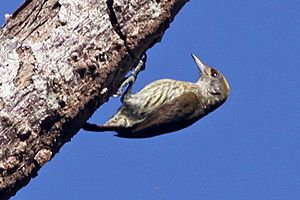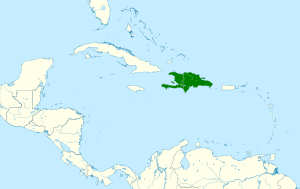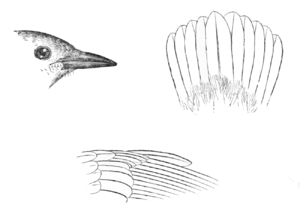Antillean piculet facts for kids
Quick facts for kids Antillean piculet |
|
|---|---|
 |
|
| Conservation status | |
| Scientific classification | |
| Genus: |
Nesoctites
|
| Species: |
micromegas
|
 |
|
The Antillean piculet (say: an-TIL-ee-an PIK-yoo-let) is a small bird. It is part of the woodpecker family. This special bird lives only on the Caribbean island of Hispaniola. This island is shared by two countries: the Dominican Republic and Haiti.
Contents
About the Antillean Piculet
The Antillean piculet is the only bird in its group, called Nesoctites. Scientists think this bird is very different from other piculets. Some even believe it should have its own special bird family!
Scientists found a fossil feather from this bird in amber. Amber is like hardened tree sap. This fossil shows that the ancestors of this bird have lived on Hispaniola for at least 25 million years.
There are two types of Antillean piculets. The main type is N. m. micromegas. The other type is N. m. abbotti.
What Does It Look Like?
The Antillean piculet is about 14 to 16 centimeters (5.5 to 6.3 inches) long. It weighs about 26 to 33 grams (0.9 to 1.2 ounces). It is the biggest piculet in the world. It is about twice the size of other piculets found in places like South America.
Adult male piculets have a bright lemon yellow head. They have a cool orange-red spot in the middle of their head. Their back is a dull olive green color. Their wings are also olive green with yellow-green edges. Their tail is brownish.
Their cheeks are a dull white with some olive stripes. Their chin and throat are white. The rest of their belly is a pale yellowish white. They have some small dark spots on their throat. Their chest and belly have wide dark stripes.
Female piculets are a bit bigger than males. They look the same as males, but they do not have the red spot on their head. Young piculets are not as bright as adults. They also do not have the red head spot. Their belly has blurry stripes instead of clear ones.
The N. m. abbotti type of piculet is paler. It has less yellow on its head. Its back is grayer. Its throat is plainer white. It also has lighter stripes on its belly.
Where Do They Live?
The main type of Antillean piculet lives all over the island of Hispaniola. The N. m. abbotti type lives only on Gonâve Island. This island is off the west coast of Haiti.
These birds live in many different places. They can be found in wet and dry forests. They also live in pine forests. You can find them in dry, bushy areas too. Sometimes, they even live in mangrove forests. They might also visit fruit farms.
No matter where they live, they like places with lots of dense plants. They are most common between 400 and 800 meters (1,300 and 2,600 feet) high. But they can live as high as 1,770 meters (5,800 feet) in some mountains.
How Do They Behave?
Movement
The Antillean piculet stays in the same area all year. It does not migrate to other places.
What Do They Eat?
Antillean piculets usually look for food low in the forest. They mostly search below 8 meters (26 feet) from the ground. But sometimes they will go higher into the treetops.
They mostly find food by picking insects off small branches, twigs, and vines. They do not often peck at tree trunks like other woodpeckers. They also look inside flowers and groups of leaves. Their diet is mostly insects. They especially like ants and beetles. They also eat other small creatures with many legs, like spiders. They eat a good amount of fruit too.
They usually hunt alone or in pairs.
How Do They Raise Their Young?
The Antillean piculet's breeding season is from February to July. They dig a nest hole in a tree stump, tree, or fence post. Sometimes, they use a hole that another woodpecker has left. Their nests are usually within 5 meters (16 feet) of the ground.
Pairs of piculets are very protective of their home. They will make loud calls and show off to scare away other birds. A female usually lays two to four eggs. Scientists do not know how long the eggs take to hatch. They also do not know how long it takes for the young birds to leave the nest.
What Sounds Do They Make?
The Antillean piculet makes many different sounds. Pairs of birds use a "kuk-ki-ki-ki-ke-ku-kuk" call to talk to each other. They also use it to tell other birds to stay away.
When they are scared, they make "pit" and "pew" sounds. If they are fighting, they make a loud "yeh-yeh-yeh-yeh" chattering sound. Unlike many other woodpeckers, these birds are not known to drum on trees.
See also
 In Spanish: Carpinterito antillano para niños
In Spanish: Carpinterito antillano para niños



